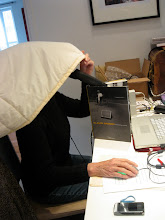Sometimes the costs are partially underwritten by selling space to advertisers who emblazon their "brand" on the coverings that are wrapped around buildings undergoing restoration. I have no idea what Samsung are paying for having this huge visual of their Galaxy S8 catch the eye of everyone going around the Place de la Concorde, but if the building underneath gets to live for another century or so, it seems like a win-win all around.
In our own neighborhood there's work going on constantly, sometimes it's restoration, sometimes it's "tear down and rebuild"! For the last seven-plus years, the Forum des Halles has undergone a real transformation from the brutalist 1960s horror that replaced the historic Baltard Pavilions, to a much more inviting space, with its swoopy loopy "Canopée" roof line that spills light all the way down to the lowest level.
Somehow, all those little shops and boutiques have taken on a new lease on life, "opened up" as it were to the world. Not so much the rat's nest it used to be.
The gardens in front of the Canopée are slowly coming together, a mix of grass, trees, shrubs, benches, and walkways for the young to practice their roller blading or zip along on their scooters. It'll take a while for it all to grow in, but it already feels like we have our own open space in the neighborhood. The building behind the Canopée is not quite as close as it looks, but it is another "modern" bit of Paris, the Centre Pompidou. Looks like a bunch of Minions are peering down at us from the rooftop!
Taking advantage of a recent rare sunny afternoon, a brass band, Les Encuivres, took up a prime spot in front of the Canopée to serenade the passers-by.
Bordering one side of our newly accessible "open space" stands the venerable Église Ste. Eustache. Built originally in 1532, it had its major restoration in the 1840's, but just recently its southern side was shielded with scaffolding and its surface scrubbed clean of decades of grime, so that it now positively glows in the late afternoon winter sun. The facade is gothic, the interior renaissance, and it boasts the biggest pipe organ in France. Every Sunday afternoon, the resident organist gives a free concert to a packed audience.
In the mid-18th century, the city erected a circular building on the site for the storage and sale of grains. It was known as the Corn Exchange. You can see Ste Eustache in the background of this print. It had already been standing there for a couple of hundred years!
In the vaulted attics, sacks of grains were stored and brought out for sale on the exchange.
A fire destroyed the old wooden dome roof in the early 19th century and was replaced with an iron dome, which is today a national landmark. Later, in the 1870s, when the corn exchange closed, beautiful murals were installed on the inside of the dome, and the building became the Commodities Exchange. Since the late 1940s, it's been known as the Paris Chamber of Commerce.
Sketches of the renovations, displayed around the sides of the building, show that the architects will build on the circularity of the structure in its re-fashioned interior. Under an oculus in the dome, visitors will be able to stroll down a winding walkway from the very top of the building (stopping into galleries at each level), all the way down to the underground auditorium. It is scheduled to open next year, looking very much the same from the outside, but with a whole new lease of life for the interior! With such a central city location, and such a distinguished art collection, it seems likely to draw a big audience.
One more recent restoration in our neighborhood is the beautiful Opera Comique building -- known as La Salle Favart -- tucked away in a small square off the rue Quatre Septembre. Founded in 1714 under the reign of Louis XIV, it is one of the oldest French dramatic and musical institutions. Twice, the Salle Favart has been destroyed by fire, the last time in the late 19th century during an actual performance, with many fatalities. In 1898, a third iteration of the building was officially opened, the one we still see today.
Scaffolding was erected, to give access to all corners of the grande salle...
...including the highly decorative ceiling.
All the plush red velvet seats were redone in the same glowing colors...
...workmen teetered on scaffolding in the stairwells and hallways...
...making sure that every last little bit of gold leaf could be retouched to perfection.
In the stunning Salon de Reception, where you go for your coupe de champagne during the intermission, you really didn't quite know where to look first.
Maybe at a slender mural devoted to the art of music...
... or an elaborate fantasy scene that wraps around an entry into yet another salon...
...or perhaps the sparkling chandelier lighting up a mural of a street scene. It was all utterly dazzling!
And then, there was the opera itself, a delightful romp of disguise and deception...
...that concluded with all three main characters entwined with each other on a bed!
No wonder the curtain calls went on for about fifteen minutes, not just a testament to the actual production and the stunning voices, the staging, music, etc., but also I suspect for the utter pleasure of being in a beautifully restored historic theatre, that, barring unforeseen tragedy, is set to entertain opera lovers for a century or more to come. I've said it before, I'll say it again: Vive la France!!
À bientôt!



























